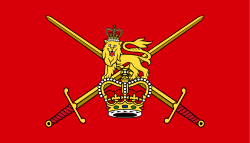History
The King's Division was formed in 1968 with the union of the Lancastrian Brigade, Yorkshire Brigade and North Irish Brigade. The depot was established at Queen Elizabeth Barracks in Strensall. [1]
Under the restructuring announced in 2004, the King's Division was reorganized into two large regiments: [2]
In 2017 the Mercian Regiment moved to the King's Division. [3]
The King's Division therefore comprised the following infantry battalions: [4]
- Regular Army Units
- Army Reserve Units
- 4th Battalion, The Duke of Lancaster's Regiment (King's Lancashire and Border)
- 4th Battalion, The Yorkshire Regiment (14th/15th, 19th and 33rd/76th Foot)
- 4th Battalion, the Mercian Regiment (Cheshire, Worcesters and Foresters, and Staffords) [5]
In addition, the King's Division also maintained a single regular army band titled the Band of the King's Division, which was a component band of British Army Bands Catterick. [6] The Band was formed through the amalgamation of two former divisional bands, the Normandy Band and the Waterloo Band. [7] Each of the three regiments, maintains a band within the reserve battalion; them being: The Band of the Yorkshire Regiment, The Band of the Mercian Regiment, and The Band of The Duke of Lancaster's Regiment.
This page is based on this
Wikipedia article Text is available under the
CC BY-SA 4.0 license; additional terms may apply.
Images, videos and audio are available under their respective licenses.
